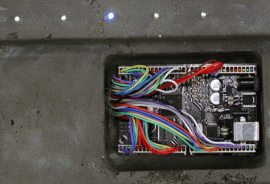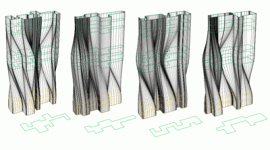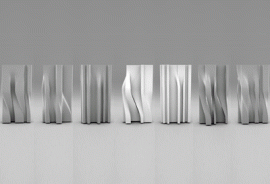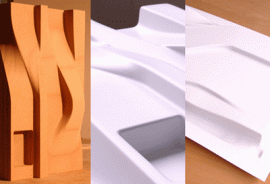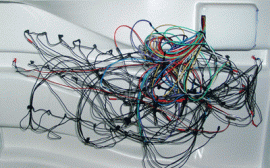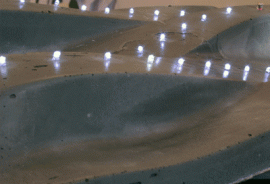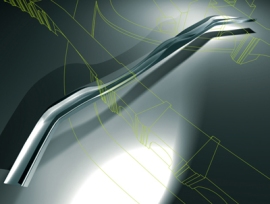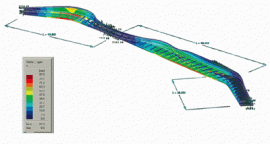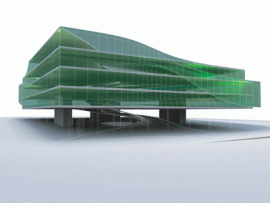Scriptedbypurpose
explicit and scripted processes within designf-u-r
f-u-r is a collaboration between Mirco Becker and Oliver Tessmann committed to design research – embracing architecture, engineering, and technology. The body of work includes prizewinning international competition entries, interactive prototypes, and an extensive teaching in architecture, algorithmic design and digital manufacturing. The practice was founded in spring 2002 after collaborating loosely in various research projects. f-u-r operates internationally and is based in Germany and the UK.
research & code
f-u-r sees research as in integral part for innovation in design culture. Technology, engineering and design are embraced as one master discipline and intensified through collaboration with specialist. Beyond these collaborative efforts f-u-r also appreciates the pure joy of discovery and world explanation. Toady’s universal mode of world explanation is code. The ongoing digitization in media, DNA sequencing, and even policies of a globalized market are all governed by the procedural syntax of code. The advent of these concepts is all but natural. It has been embedded by tremendous efforts. It not only delivers a model of explanation but also provides modes of engagement; engagement with complexities that where out of reach for a long time.
design
Our research trajectory points towards the very core of design: the synthesis of conflicting aspects. In the context of architectural practice and thinking we see a chance to overcome the traditional model of translating a set of abstract representations into a building which is comprised of known (building-) components. We rather believe that digital tools could be developed into a setting that binds together higher complexities and leads beyond the traditional, known and tested. The core interest includes physical and performative models making, modes of digital- and craft-driven fabrication, and computational simulation and analysis.
embedding code
Embedding code in the design process or in the actual artifact does not come with any formal demands although it could act as a driver for form development. The most groundbreaking aspect of the use of code is on blurring the lines between physical artifacts and the digital. The difference between computers and analogue devices is already quite blurred as microprocessors, sensors and RAM enter more and more products. f-u-r started these investigations already with projects like roboSCAPE (2000) an 3d web engine and technoCLOUD (2002) an interactive mechanical prototype build on pneumatic components.
scripted by purpose
The exhibition we took as an opportunity to pull together two aspects of our work. A script library of modelling methods we developed over the course of a couple of architectural projects and a prototype that is designed with this function library. The library of design function, isoSTEROIDS pivots around particular aspects of NURB surface modeling giving particular control over the surface parametrisation. It captures the aesthetic rigor on a generic level enabling us to cast acquired design expertise into new projects.
The prototype aggregate was designed using the isoSTEROIDS framework for form generation. The body is cast in Ultra High Performance Concrete (UHPC) embedding networked electronic components. UHPC is a concrete with an extreme dense micro-structure and steel fiber supplements. Without any additional steel reinforcement it is even more capable than traditional concrete allowing delicate formwork and an astonishing surface quality. UHPC and electronic components form one aggregate which performs as an prototype for material embedded sensing-, computation-, and display-system.
aggregate points towards new use of material where smart supplements excel the fundamental properties of the material. More than the addition of devices this approach has the potential to be fully groundbreaking as the generic components are fully networked and programmable. This meta-material which can be programmed using the wiring programming environment can act a a display and sensing device. The enterprise of using concrete with networked supplements is just the initial investigation of an architectural design research project with upcoming projects on the way. f-u-r sees the potential of blurring the lines between structure, surface, ambient effects and smart environments.
precedence
skyWALK
Design Project, Vienna, 2004
The proposal for a pedestrian bridge is based on the notion of developable steel surfaces. The form is entirely generated from a set of cross sections. It seems as if the topology of the cross sections changes along the bridge path. This effect is established by inserting more control points than needed and aligning them where not needed. By this method sharp edges can blend perfectly into smooth surfaces. That is the core effect of isoSTEROIDS modeling.
collars
Design Project, Prague, 2006
The facades for a public library proposal are generated with a similar method as invented for skyWALK. It incorporates set-backs, balconies, and double facades in a continuous manner. Other than the bridge this deign proposes transparent surfaces that are governed by different constraints as developable steel plates.
Index:
UHPC (Ultra High Performance Concrete) is a concrete with an extreme dense micro-structure generated by powder-like silica sand. The material density is responsible for a compression strength that is almost comparable to steel and a surface quality that reflecting perfectly the material used as mould. Equipped with steel fibres as a part of the aggregate the self-compressing material can be disburdened from traditional rebars while providing high tensile strength.
Wiring is an open source programming environment and electronics i/o board for exploring the electronic arts, tangible media. It is developed by Hernando Barragan and build on Processing.
Team:
f-u-r Mirco Becker, Oliver Tessmann
David Seeland, Jan Alexander Wecker
gtecz Gregor Zimmermann, Thomas Teichmann
